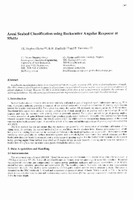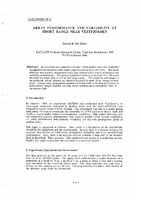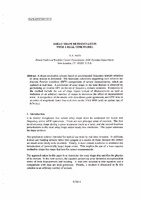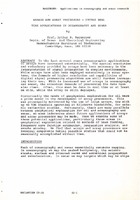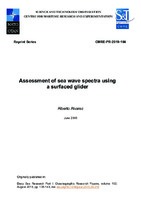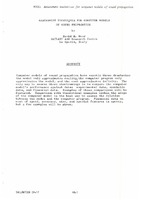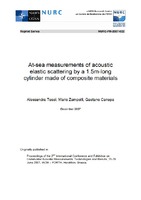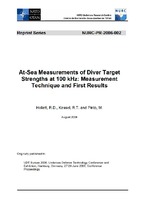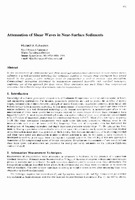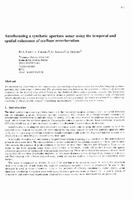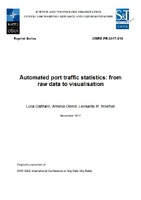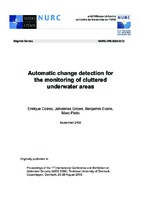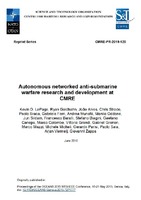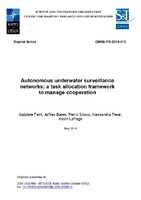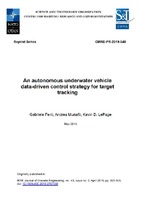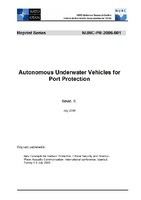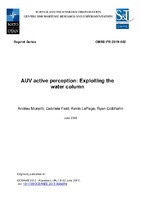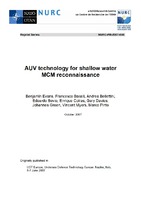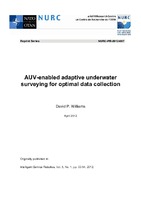Browsing Reprints by Title
Now showing items 88-107 of 548
-
Areal seabed classification using backscatter angular response at 95kHz
(NATO. SACLANTCEN, 1997)A sediment classification scheme is developed based on the angular response (AR) of the seabed backscatter strength. The AR is characterised based on its mean level and slope over predefined angular sectors, and the presence ... -
Array and cable tracking data through ship maneuvers
(NATO. SACLANTCEN, 1993/08)This paper presents tracking results from two sea tests in which a towed cable and array were tracked at the Atlantic Undersea Test and Evaluation Center (AUTEC). The tracking tests involved instrumenting the cable with ... -
Array performance and variability at short range near Vestfjorden
(NATO. SACLANTCEN, 1993/08)An experiment was conducted in October 1989 in shallow water near Vestfjorden in support of low frequency active sonar system research at SACLANTCEN. This report addresses some acoustic measurement results from that test ... -
Array shape determination with a real-time model
(NATO. SACLANTCEN, 1993/08)A shape estimation scheme based on precomputed frequency-domain solutions of array motion is presented. The boundary conditions supporting each solution are discrete Fourier transform (OFT) components of sensor measurements, ... -
Arrays and array processors: future real time applications in oceanography and sonar
(NATO. SACLANTCEN, 1979/12)In the last several years oceanographic applications of arrays have increased substantially. The spatial resolution and redundancy provided by arrays have been necessary in the interpretation of signal propagation in complex ... -
Assessment of sea wave spectra using a surfaced glider
(CMRE, 2019/06)The determination of non-directional and directional sea wave spectra is attempted by analysing the dynamical response of a surfaced Slocum glider. The method makes use of the glider heave motion to infer non-directional ... -
Assessment techniques for computer models of sound propagation
(NATO. SACLANTCEN, 1975/10)Computer models of sound propagation have exactly three drawbacks: the model only approximates reality,the computer program only approximates the model, and the cost approximates infinity. The only way to assess these ... -
At-sea measurements of acoustic elastic scattering by a 1.5m-long cylinder made of composite materials
(NURC, 2007/12)Monostatic and bistatic acoustic scattering measurements were performed on solid-filled fibreglass objects (a sphere and a cylinder with hemispherical endcaps) deployed proud on a sandy seabed and insonified by a rail-mounted ... -
At-sea measurements of diver target strengths at 100 Khz: measurement technique and first results
(NURC, 2006/08)During a recent at-sea trial of a diver detection system, the opportunity was taken of developing a technique for in-situ measurement of diver target strengths. The technique was based on making the diver perform circular ... -
Attenuation of shear waves in near-surface sediments
(NATO. SACLANTCEN, 1997)In situ measurement of compressional and shear speed and compressional attenuation in near-surface marine sediments is a well-developed technology but techniques required to measure shear attenuation have lagged behind. ... -
Autofocusing a synthetic aperture sonar using the temporal and spatial coherence of seafloor reverberation
(NATO. SACLANTCEN, 1997)An autofocusing algorithm for the compensation of translational motion errors of a sea floor rmaging synthetic aperture side scan sonar is presented. The algorithm does not depend on the presence or absence of dominant ... -
Automated port traffic statistics: from raw data to visualization
(CMRE, 2017/11)We describe how we leveraged best practices in big data processing pipeline design and visual analytics to prototype the Maritime Patterns-of-Life Information Service (MPoLIS), an information product currently under ... -
Automatic change detection for the monitoring of cluttered underwater areas
(NURC, 2008/09)Automating the surveillance of cluttered underwater areas (such as ports) poses several problems, the main one being the high number of contacts that any automatic target recognition (ATR) system will produce when surveying ... -
Autonomous networked anti-submarine warfare research and development at CMRE
(CMRE, 2019/06)CMRE has been evaluating the potential of autonomous networked ASW using underwater vehicles through a program of sonar signal processing, underwater communications, navigation and robotic behavior developments and at-sea ... -
Autonomous underwater surveillance networks: a task allocation framework to manage cooperation
(2019/05)The design of efficient task allocation schemes is essential to manage autonomous underwater robotic surveillance networks. The network has to assign the most suited robots to the tasks which compose the mission, in spite ... -
An autonomous underwater vehicle data-driven control strategy for target tracking
(CMRE, 2019/05)This paper presents a data-driven approach to control the movement of autonomous underwater vehicles (AUVs) operating as receivers of a multistatic sonar surveillance network. The algorithm adopts a nonmyopic receding ... -
Autonomous underwater vehicles for port protection
(NURC, 2006/07)NATO's present capability to deal with a terrorist threat to our ports is slow, dangerous, and inefficient. Ports are a challenging area within which to conduct MCM operations due to several factors: shipping movements, ... -
AUV active perception: exploiting the water column
(CMRE, 2019/06)Autonomous Underwater Vehicles (AUVs) present a low-cost alternative or supplement to existing underwater surveillance networks. The NATO STO Centre for Maritime Research and Experimentation is developing collaborative ... -
AUV technology for shallow water MCM reconnaissance
(NURC, 2007/10)The ability to perform MCM reconnaissance missions in shallow water is important in both expeditionary MCM and in the protection of ports against maritime improvised explosive devices (MIEDs). For many years AUV systems ... -
AUV-enabled adaptive underwater surveying for optimal data collection
(NURC, 2012/04)A new adaptive strategy for performing data collection with a sonar-equipped autonomous underwater vehicle (AUV) is proposed. The approach is general in the sense that it is applicable to a wide range of underwater tasks ...
